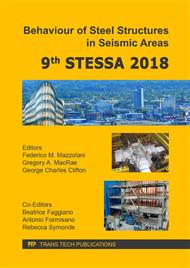[1]
CEN. Eurocode 8: Design of structures for earthquake resistance - Part 1: General rules, seismic actions and rules for buildings, 2005a.
DOI: 10.3403/03244372
Google Scholar
[2]
Mazzolani, F.M., Piluso, V., Plastic Design of Seismic Resistant Steel Frames, Earthquake Engineering and Structural Dynamics, Vol. 26, pp.167-191, (1997).
DOI: 10.1002/(sici)1096-9845(199702)26:2<167::aid-eqe630>3.0.co;2-2
Google Scholar
[3]
Montuori, R., Nastri, E., Piluso, V., Advances in Theory of Plastic Mechanism Control: Closed Form Solution for Mr-Frames, Earthquake Engineering and Structural Dynamics, (2015).
DOI: 10.1002/eqe.2498
Google Scholar
[4]
Montuori, R., Nastri, E., Piluso, V., Theory of plastic mechanism control for MRF-EBF dual systems: Closed Form Solution, Engineering Structures, (2016).
DOI: 10.1016/j.engstruct.2016.03.050
Google Scholar
[5]
Longo, A.; Montuori, R.; Piluso, V. Theory of Plastic Mechanism Control for MRF-CBF dual system and its validation, Bulletin of Earthquake Engineering (BEEE), (2014).
DOI: 10.1007/s10518-014-9612-2
Google Scholar
[6]
Giugliano M.T., Longo A., Montuori R., Piluso V. Failure mode and drift control of MRF-CBF dual systems, The Open Construction and Building Technology Journal, 4, 121-133, (2010).
DOI: 10.2174/18748368010040100121
Google Scholar
[7]
Montuori R., Piluso V., Troisi M. Theory of plastic mechanism control of seismic-resistant MR-frames with set-backs, Open Construction and Building Technology Journal, vol. 6, pp.404-413 , (2012).
DOI: 10.2174/1874836801206010404
Google Scholar
[8]
Longo A., Montuori R., Piluso V., Theory of Plastic Mechanism Control of Dissipative Truss Moment Frames, Engineering Structures, Vol. 37, pp.63-75, (2012).
DOI: 10.1016/j.engstruct.2011.12.046
Google Scholar
[9]
Longo A., Montuori R., Piluso V., Failure Mode Control and Seismic Response of Dissipative Truss Moment Frames, Journal of Structural Engineering, Vol. 138, pp.1388-1397, (2012).
DOI: 10.1061/(asce)st.1943-541x.0000569
Google Scholar
[10]
Longo A., Montuori R., Nastri E., Piluso V., On the use of HSS in seismic-resistant structures, Journal of Constructional Steel Research, Vol. 103, pp.1-12, (2014).
DOI: 10.1016/j.jcsr.2014.07.019
Google Scholar
[11]
Longo A., Montuori R., Piluso V., Moment Frames - Concentrically Braced Frames Dual Systems: Analysis of Different Design Criteria, Structure and infrastructure engineering, Volume 12, Issue 1, 2 January 2016, pp.122-14.
DOI: 10.1080/15732479.2014.996164
Google Scholar
[12]
Longo A., Nastri E., Piluso V., Theory of plastic mechanism control: State-of-the-art, Open Construction and Building Technology Journal, Volume 8, Pages 262-278, (2014).
DOI: 10.2174/1874836801408010262
Google Scholar
[13]
Longo A., Montuori R., Piluso V., Failure mode control of X-braced frames under seismic actions, Journal of Earthquake Engineering, 12: 728-759, (2008).
DOI: 10.1080/13632460701572955
Google Scholar
[14]
Longo A., Montuori R., Piluso V., Plastic design of seismic resistant V-Braced frames, Journal of Earthquake Engineering, vol. 12: 1246-1266, (2008).
DOI: 10.1080/13632460802211867
Google Scholar
[15]
Longo A., Montuori R., Piluso V., Influence of design Criteria on the seismic Reliability of X-Braced Frames, Journal of Earthquake Engineering, Vol. 12, Issue 3– pp.406-431, (2008).
DOI: 10.1080/13632460701457231
Google Scholar
[16]
Montuori R., Nastri E., Piluso V., Rigid-plastic analysis and moment–shear interaction for hierarchy criteria of inverted Y EB-Frames, Journal of Constructional Steel Research, vol. 95 71-80, (2014).
DOI: 10.1016/j.jcsr.2013.11.013
Google Scholar
[17]
Montuori R., Nastri E., Piluso V., Theory of Plastic Mechanism Control for Eccentrically Braced Frames with inverted Y-scheme, Journal of Constructional Steel Research, Volume 92, pp.122-135, (2014).
DOI: 10.1016/j.jcsr.2013.10.009
Google Scholar
[18]
Montuori, R., Nastri, E., Piluso, V., Troisi, M. Influence of connection typology on seismic response of MR-Frames with and without set-backs, (2017) Earthquake Engineering and Structural Dynamics, 46 (1), pp.5-25.
DOI: 10.1002/eqe.2768
Google Scholar
[19]
Montuori, R., Nastri, E., Piluso, V., Troisi, M. Influence of the cyclic behaviour of beam-to-column connection on the seismic response of regular steel frames (2015) Ingegneria Sismica, 33 (1-2), pp.91-105.
Google Scholar
[20]
Montuori R., Muscati R., Plastic design of seismic resistant reinforced concrete frame, Earthquake and Structures, Volume 8, Issue 1, pp.205-224, (2015).
DOI: 10.12989/eas.2015.8.1.205
Google Scholar
[21]
Christopoulos C. and Filiatrault A., Principles of Passive Supplemental Damping and Seismic Isolation, IUSS PRESS, Pavia, (2006).
DOI: 10.1061/(asce)0733-9445(2007)133:8(1192)
Google Scholar
[22]
Soong T.T. and Spencer Jr B.F., Supplemental Energy Dissipation: State-of-the-Art and State-of-the-Practice, Engineering Structures, 24, 243-259, (2002).
DOI: 10.1016/s0141-0296(01)00092-x
Google Scholar
[23]
Mualla I. and Belev B., Seismic Response of Steel Frames Equiped with a New Friction Damper Device Under Earthquake Excitation2, Engineering Structures, 24, 365-371, 3-(2002).
DOI: 10.1016/s0141-0296(01)00102-x
Google Scholar
[24]
Oh S., Kim Y., and Ryu H., Seismic Performance of Steel Structures with slit dampers, Engineering Structures, 31, (2009), 1997-(2008).
DOI: 10.1016/j.engstruct.2009.03.003
Google Scholar
[25]
Khoo, H. -H., Clifton, C., Macrae, G., Zhou, H., Ramhormozian, S. Proposed design models for the asymmetric friction connection, 2015, Earthquake Engineering and Structural Dynamics, 44 (8), pp.1309-1324.
DOI: 10.1002/eqe.2520
Google Scholar
[26]
Latour M., Piluso V. and Rizzano G., Free from damage beam-to-column joints: Testing and design of DST connections with friction pads, Engineering Structures, Volume 85, pp.219-233, February 05, (2015).
DOI: 10.1016/j.engstruct.2014.12.019
Google Scholar
[27]
Latour M., Piluso V. and Rizzano G., Experimental analysis of innovative dissipative bolted double split tee beam-to-column connections, Steel Construction, 4, 53-64, 2 June 2011a.
DOI: 10.1002/stco.201110009
Google Scholar
[28]
Goel S.C., Lee S-S., Performance-Based Design of Steel Moment Frames using Target Drift and Yield Mechanism, Research Report UMCEE 01-17, December (2001).
Google Scholar
[29]
Montuori R., Piluso V., Troisi M., Innovative structural details in MR-frames for free from damage structures, Mechanics Research Communications, Vol. 58, pp.146-156, (2014).
DOI: 10.1016/j.mechrescom.2014.04.002
Google Scholar
[30]
Streppone S., Seismic performances evaluation of steel MR-Frames equipped with FREEDAM connections, MSc Thesis, (2017).
Google Scholar
[31]
CEN. Eurocode 3: Design of steel structures - Part 1-1: General rules and rules for buildings, 2005b.
Google Scholar
[32]
Montuori R., Nastri E., Piluso V., Streppone S., The use of TPMC for designing MRFs equipped with FREEDAM connections: performance evaluation, Behaviour of Steel Structures in Seismic Areas, 14-17 February 2018, Christchurch, New Zealand.
DOI: 10.4028/www.scientific.net/kem.763.983
Google Scholar


